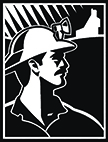
MIGRATING SANDS and BUFFALO REEF
The Mohawk and Wolverine Mills in Gay discharged around 25 million tons of tailings which locals call “stamp sands.” The coarse-grained sand formed an expanding bank below the mills on the shoreline. The finer-grained sands drifted offshore and spread southward along the Keweenaw’s shoreline.
Aided by coastal waves and currents, the stamp sands spread southward along beaches and the shoreline, damming Tobacco and Traverse River outlets, and moving into wetlands. Aerial and satellite images of the Gay coastline from 1938 to 2016 show the erosion of the sand bank. Credit: Colin Brooks, Michigan Tech University, MTRI
Over nearly 100 years, the sands have moved along the shore to the mouth of the Traverse River and gradually replaced the finer white limestone sands of Traverse Bay with the course sticky black sands of Gay. Some sands have migrated north to the Tobacco River. Aerial photography and satellite imagery suggest that Gay’s sand bank has eroded into Lake Superior at a rapid rate - 26 feet per year. Some estimate it will be completely dispersed downshore or underwater by 2082. Today the equivalent of 100,000 railroad cars of Gay stamp sands lie hidden under the water’s surface.
Offshore from Gay to the south sits Buffalo Reef, where migrating stamp sands pose a serious threat to the whitefish and lake trout spawning grounds. Composed of various sized stones and boulders deposited by glaciers, the reef has been filling up with copper-rich sands for years. An important fish breeding ground in the Great Lakes, Buffalo Reef offers a necessary food supply for young fish. With high concentrations of copper, the stamp sands cover up and diminish the food system. Full coverage of the reef with the sands will eliminate this fishery within just sixty years.
Buffalo Reef Cobblestone Field
Take a look underwater with Michigan Tech’s remote operating vehicle (ROV) to see what Buffalo Reef looks like and the effects of Gay’s stamp sands on Lake Superior’s fish spawning grounds.
Most of the cobbles are glacial rocks, scattered around the Jacobsville Sandstone bedrock. During spawning, fish drop eggs into crevices between rocks.
Cobbles are coated with a natural organic film that is a basis of a food web for feeding fish.
Stamp sands moving into the northern cobblefield of Buffalo Reef burying cobbles and killing living communities on rocks along the leading edge. Credit: W.C Kerfoot, Michigan Tech University, GLRC.
Migrating stamp sands diminish recreational fishing for all, and commercial fishing for the Keweenaw Bay, Red Cliff, and Bad River Indian Communities in Keweenaw Bay. Harvesting these fish is important to the Ojibwa traditional food system and economy around Lake Superior. Gay’s shores are rearing ground for whitefish, and local streams and rivers are necessary for smelt and steelhead migration and spawning.
Estimates suggest Buffalo Reef produces 32% of the lake trout and whitefish caught in Keweenaw Bay and 22% caught along Lake Superior’s southern shore.
Whitefish spawn at Buffalo Reef in the late fall and feed upon the macroinvertebrates the following spring. Courtesy: Michigan Sea Grant
Sands also affect the coastal wetlands as they migrate up the streams and deposit copper-toxic material in amphibian and plant habitats. Damage to the reef habitat could lead to a decline in important fish species, infringement upon federally guaranteed treaty reserved rights, and negatively affect the health of anyone consuming them.



